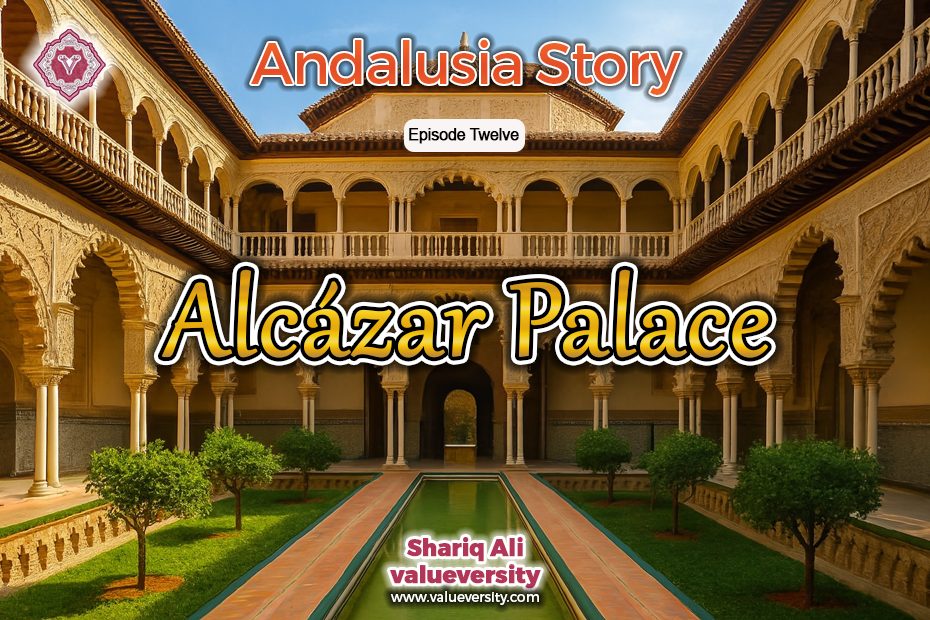Alcázar Palace, Andalusian Story,
Episode 12
By Shariq Ali
Valueversity
As we entered the hotel dining hall for breakfast, the atmosphere was refined yet bustling. Local and foreign tourists moved about, while the wide tables displayed lavish breakfast spreads. The bakery corner released the mouth-watering aroma of freshly baked items, mingled with the strong fragrance of coffee. On one tray lay fresh honey, still in its natural comb, ready to be scooped out with a spoon. Most captivating, however, was a corner table adorned with Spain’s vibrant fresh fruits: bunches of grapes, the bright hues of oranges, apples, pears, cherries, strawberries, melons, and watermelons—a delightful and colorful selection, all delicious and inviting.
With the arrival of Muslims, Andalusia witnessed a great agricultural revolution. The Arabs introduced an organized canal system, dug waterways, and devised new methods for distributing water. As a result, the production of olives, grapes, wheat, and vegetables increased enormously. Arab agricultural knowledge offered local farmers new tools, techniques, and crops. Dates and rice also began to take root in Andalusian soil during this period.
This was not merely progress in farming but a cultural revolution. Andalusia’s fertile lands became a model for the rest of Europe. From here, knowledge, experience, and flavors spread across the continent.
So today, as we taste these fresh fruits at breakfast, it feels as though we are paying tribute to the centuries-old foresight and labor that turned Andalusia into a land of gardens and prosperity.
After breakfast, we descended the hotel stairs and set off on foot through the streets of Seville towards the Alcázar Palace. Along the roads, orange and lemon trees laden with fruit were a common sight. Although their fruit is not edible, their colors and charm stand as a testament to Spain’s fertility. Locals walked past them with indifference, while in the marketplace some shopkeepers arranged their displays and a few people sat outside cafés, chatting over mugs of coffee.
Through these lively, bustling scenes, we eventually arrived at the fountain in front of the Alcázar Palace’s main gate, where we were to meet our tour guide. The tour was scheduled to begin at one o’clock, but we arrived fifteen minutes early.
We sat on the granite steps. A gentle spray from the fountain occasionally touched us playfully with the breeze. Around us, other groups of tourists gathered, as though several tours were to begin from the same spot.
Soon our guide appeared—a cheerful university student of history, holding a long floral umbrella and wearing an ID card around her neck. After a brief introduction and instructions, she gestured: “Follow me, or rather, follow the umbrella you see raised above the crowd.”
In front of the main gate stretched a long line of tourists. Our guide showed the chief guard officer the company card and whispered a few words. Immediately, a separate door was opened for our group. We entered quickly, thanks to our special entrance tickets included in the tour package.
The moment we stepped inside, the atmosphere—at least to me—seemed deeply connected with the golden era of Arab Andalusia.
We entered through the “Lion’s Gate” (Puerta del León). Once a symbol of Muslim rulers’ grandeur, it was broad enough for a carriage to pass through with ease. It is said that nobles would ride in on horseback, while commoners had to walk. The horses were then handed to attendants, and those presenting themselves at court would prepare in a large chamber (a Diwan-e-Aam, or hall of audience), before being ushered with their gifts before the king.
Moving further toward the central building, we saw a vast courtyard where rulers once welcomed distinguished guests. Stone walls, carved arches, and Arabic inscriptions still testify that Islamic architecture once flourished here at its zenith.
The guide explained that the true heart of the present palace lies in the section built by Abu Abdullah Muhammad ibn Abbad, later expanded by the Almohad rulers. From here emerged the Mudéjar style—an exquisite blend of Islamic architecture with later Christian additions. The Arabic calligraphy, delicate stucco work, and green-and-blue ceramic tiles still shine as masterpieces of Muslim craftsmanship.
The most enchanting sight was the “Patio of the Maidens” (Patio de las Doncellas): a long reflecting pool in the center, surrounded by rows of arches. Every wall was decorated with Arabic inscriptions and geometric patterns, as if each brick bore witness to history.
We also reached the “Hall of Ambassadors,” the very Diwan-e-Khas where Andalusian caliphs met envoys and dignitaries. Above was a golden dome, below a dazzling display of azulejo tiles, and around us, arches opening in three directions—a radiant example of Islamic artistry and architecture.
The guide showed us the king’s private chambers, the royal kitchens, and the Baños de María de Padilla (baths). The system of water and light in these baths reflects the engineering brilliance of Arab builders. In the arched corridors, the damp air and dim light still seem to whisper centuries-old stories.
The gardens of the Alcázar too appear as a Muslim legacy—canals, pools, fruit trees, and the pervasive scent of oranges. All of it echoes the agricultural heritage the Arabs left behind.
Step by step, it felt as if the Alcázar was not just a palace but an open book of Andalusian civilization, architecture, and craftsmanship. Today, this palace is recognized as a UNESCO World Heritage Site.
A living monument to those Andalusian days when philosophical debates, artistic gatherings, agricultural revolutions, and Arab traditions thrived together.
